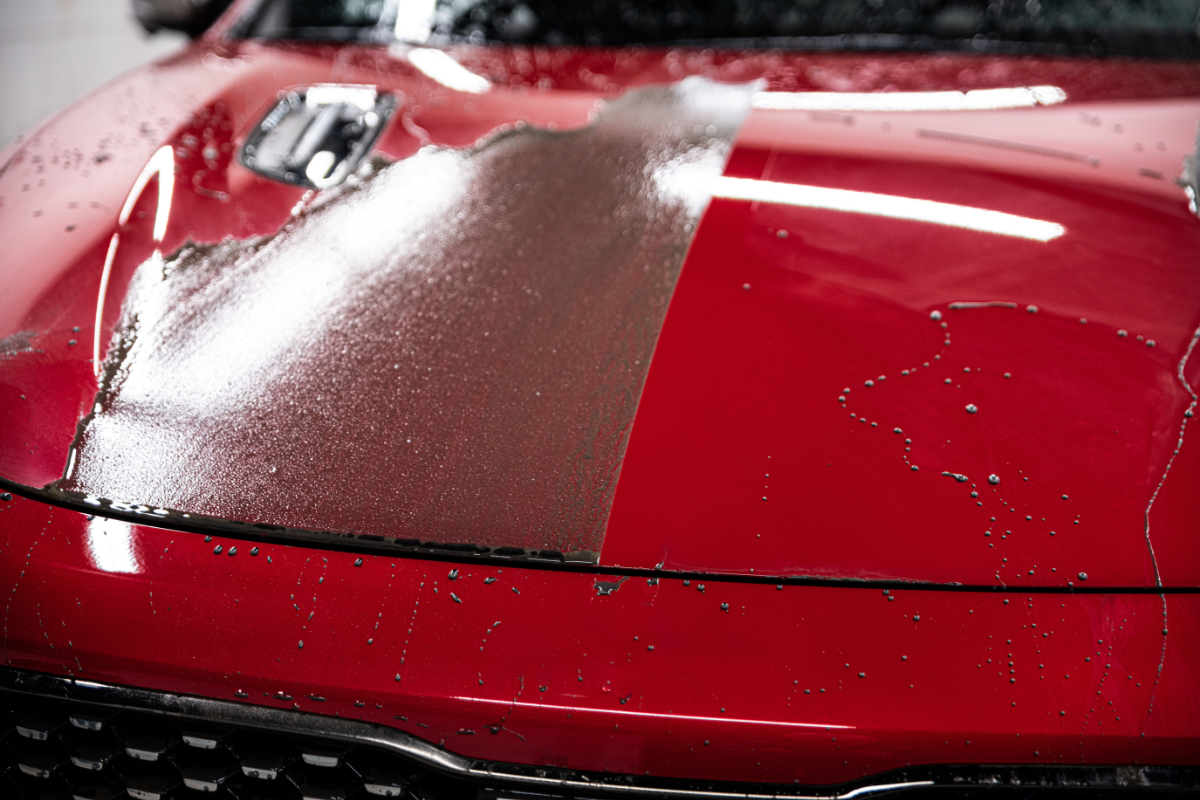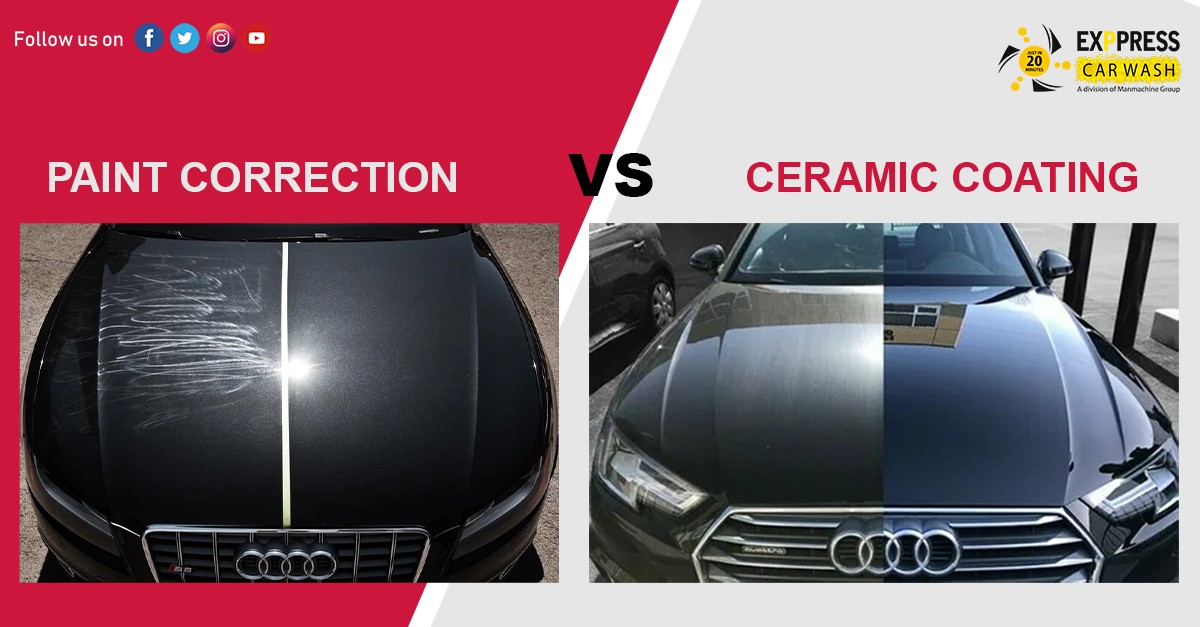Ceramic Coating: Just How It Offers Unmatched Security and Gloss for Your Lorry
Wiki Article
Discovering the Scientific Research Behind Ceramic Layer and Its Influence On Vehicle Outlining
The application of ceramic layer in cars and truck describing represents a substantial development in vehicle care, rooted in its sophisticated chemical buildings, primarily silica dioxide and titanium dioxide. As we discover the complexities of the application process and the long-lasting ramifications for automobile upkeep, it becomes clear that the choice of ceramic coating can essentially modify one's technique to vehicle treatment.What Is Ceramic Coating?
Ceramic coating is a modern-day service that has gained popularity in the automotive describing market for its capability to supply long-lasting security for vehicle surface areas. This advanced safety layer is generally composed of silica dioxide (SiO2), which develops a strong bond with the lorry's paint, developing a resilient shield versus environmental contaminants. Unlike conventional wax or sealers, ceramic coatings supply exceptional resistance to UV rays, chemical stains, and physical abrasions.
The application of ceramic covering involves a meticulous process, where the automobile's surface is extensively cleaned up and decontaminated before the finishing is applied (Ceramic Coating). As soon as treated, the finishing boosts the car's gloss, deepness, and quality, supplying a showroom-quality surface that lasts for several years. Among the key benefits of ceramic coating is its hydrophobic homes, which drive away water and dirt, making upkeep less complicated and minimizing the regularity of laundries
The Chemistry of Ceramic Layer
A basic element of ceramic finish lies in its chemical make-up, primarily defined by the existence of silica dioxide (SiO2) This substance is integral to the formation of a resilient, protective layer that bonds chemically to the vehicle's surface area.Along with SiO2, several ceramic layers integrate titanium dioxide (TiO2) and other ingredients to improve their efficiency features. TiO2, for example, adds to boosted firmness and chemical resistance. The communication in between these compounds produces an one-of-a-kind molecular structure that provides a high level of defense against ecological variables such as UV rays, acid rainfall, and oxidation.
In addition, the application process usually includes a careful prep work of the surface to guarantee optimum bond of the covering. This chemistry not only makes certain a lasting finish however likewise boosts the visual charm of the car. Understanding the intricate chemistry behind ceramic finishes is essential for describing professionals that aim to give exceptional defense and long life for their clients' vehicles.
Benefits of Ceramic Coating
While detailing experts usually highlight the benefits of ceramic finishes, their benefits extend far past aesthetic appeals. The primary advantage transcends security against ecological pollutants. Ceramic finishings create a hydrophobic surface area that repels water, grime, and dirt, considerably minimizing the regularity of laundries and the effort needed to keep a car's appearance. This safety layer likewise guards the paint from dangerous ultraviolet rays, stopping oxidation and fading over time.Furthermore, ceramic coverings enhance the durability of the automobile's surface. Unlike conventional waxes or sealants, which may last a couple of months, ceramic finishings can endure for several years, providing a long-term option for car treatment. This durability translates to set you back savings, as proprietors are much less likely to require frequent reapplication.
Additionally, ceramic finishings are immune to chemical discolorations and etching, which can happen from acidic compounds like bird droppings or tree sap. This resistance not only protects the automobile's aesthetic appeals but also reduces prospective damage - Ceramic Coating. On the whole, the investment in ceramic layer offers car proprietors a substantial return in terms of protection, convenience of upkeep, and lasting aesthetic allure, making it a progressively preferred choice in the realm of vehicle detailing
Application Process Discussed

Once the surface is appropriately prepared, the ceramic finishing can be used. Making use of an applicator pad, the professional uses the layer in tiny areas, working in a crosshatch pattern to make certain also insurance coverage.
Click Here After using the finishing, the lorry needs to be permitted to heal, which may take numerous hours to numerous days, relying on the particular item made use of. During this duration, it is important to maintain the car far from wetness and impurities. Once healed, the ceramic covering forms a strong bond with the paint, supplying boosted protection and a shiny surface. Appropriate application is crucial to optimize the long life and efficiency of the ceramic layer.

Long-term Influence On Vehicle Care
The lasting influence of ceramic layer on automobile care is substantial, as it fundamentally modifies exactly how proprietors keep their lorries. By developing a resilient, hydrophobic layer on the vehicle's surface, ceramic coatings reduce the adherence of dust, crud, and impurities. This property reduces the regularity of cleaning needed, ultimately preserving water and cleaning items.Furthermore, the UV protection offered by ceramic coverings aids to prevent oxidation and fading of the lorry's paint, preserving its visual appeal and resale value in time - Ceramic Coating. This safety barrier likewise decreases the chance of scratches and swirl marks, which are typical concerns in standard paint finishes
Additionally, ceramic finishes promote much easier upkeep, enabling proprietors to cleanse their automobiles with minimal initiative. The smooth surface area makes it difficult for contaminants to bond, allowing simpler elimination throughout routine cleaning.
In the future, the investment in ceramic layer might lead to set you back financial savings in vehicle care items and services. On the whole, the sustaining benefits of ceramic coatings not just improve the appearance of lorries yet likewise add to a much more reliable and lasting method to vehicle upkeep.
Verdict
In final thought, from this source the application of ceramic finish stands for a substantial innovation in cars and truck detailing, driven by its unique chemical make-up of silica dioxide and titanium dioxide. This technology not just boosts the visual allure of vehicles but additionally supplies robust defense versus ecological risks and wear. The lasting advantages, consisting of reduced maintenance frequency and boosted durability, underscore the value of ceramic finishes as a vital investment for keeping vehicle look and integrity with time.
Report this wiki page